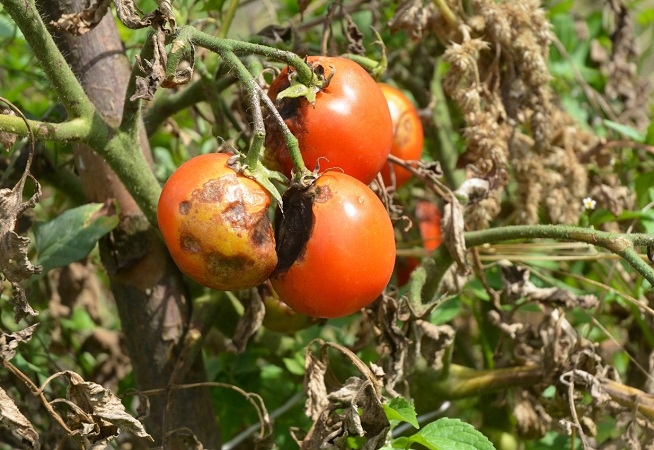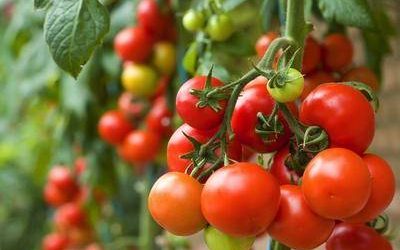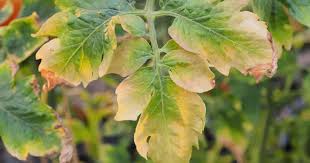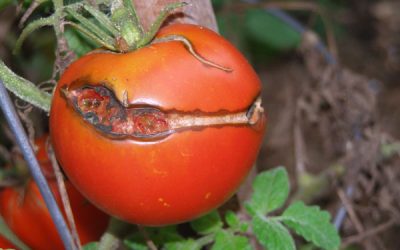
Biting into slices of freshly picked, ripe, juicy tomatoes from the garden is one of the great pleasures of life. You cannot help feel depressed and disappointed if your tomato plants wilt and the fruits rot on the vine. Common fungal diseases, such as early blight, late blight and fusarium wilt, cause wilting and rotting of tomatoes. Tomatoes may also rot as a result of pests, diseases and cultural conditions. A common environmental problem encountered by home gardeners is blossom end rot.
Early Blight
Early blight on tomatoes is characterized by black and brown spots on stems, leaves and fruit. The fungus Alternaria solani causes early blight. The spots often form concentric circles and may develop a yellowish surrounding area. Spots first appear on the lower or older leaves. The disease spreads from the bottom to the top of the plant. Overhead watering and cool, humid conditions favor disease progression and may cause severe damage to plants and fruits. To control or slow the disease, remove dead, infected foliage when you first see it and mulch around the tomato plants. Another way to control disease is to apply a copper fungicide every seven to 10 days.
Late Blight
The fungus Phytophthora infesters causes late blight on tomatoes, potatoes and other vegetables. The Irish potato famine illustrates the serious damage that this fungus can inflict. Late blight on tomatoes causes irregular, grayish green, purple or dark brown spots on stems and leaves. Spots enlarge and spread rapidly and involve the emerging fruit. Sometimes, whitish mold, containing the fungal spores, forms on the underside of infected leaves. Fruits develop brown and black lesions but stay firm. Late blight spreads quickly during periods of high humidity coupled with warm temperatures. The disease can kill tomato plants within days. Remove affected plants and all plant debris near healthy plants to prevent the spread of the disease. Avoid overhead watering because it may help spread the disease.
Fusarium Wilt
Fusarium wilt affects all parts of the tomato plant and is caused by the soil-dwelling fungus Fusarium oxysporum. The disease begins with yellowing of foliage, usually on only one side of the plant. Wilting may spread to the whole plant even if sufficient soil moisture is available. Cutting open infected stems reveals brown streaks. The disease blocks the transport of water and nutrients from the roots to the rest of the plant. Although it is difficult to rid the soil of fusarium wilt fungus, you may succeed if you solarize the soil.
Solarization is a method that raises soil temperature. It is best to grow tomato varieties resistant to fusarium wilt if you know that your soil harbors the fusarium fungus. Tomato plants resistant to fusarium wilt are marked with one or more “F” on the label.
Blossom End Rot
When rotting spots form on the blossom end of ripening tomatoes, the condition is called “blossom end rot.” It may start out as a small spot, but it soon takes over most of the fruit. Blossom end rot is not caused by a pathogenic organism — it is caused by environmental conditions that result in low levels of calcium and water in the fruit and plant. Tomatoes grown in sandy or low-moisture soils are most susceptible to blossom end rot. Blossom end rot will not be cured with any pesticide because it is not caused by a pathogenic organism. Prevent blossom end rot by checking the soil moisture of your planted tomatoes and water them when the soil gets too dry, but do not overwater. Adding tomato fertilizer will help prevent blossom end rot by keeping your plants vigorous and free of nutritional deficiencies.


